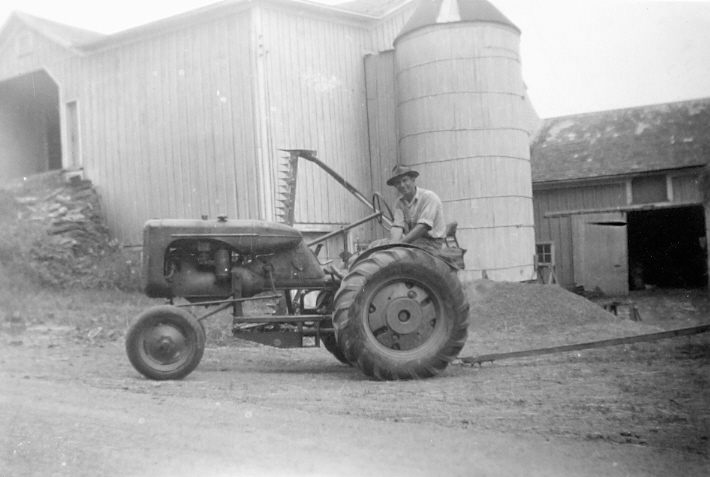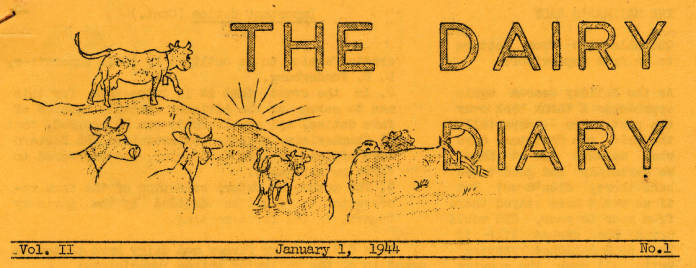CPS Camp Number 097
Technical Agency: Agriculture Experiment Station
Summary:
CPS Unit No. 97, a Dairy Farm unit operating in thirty-four counties within fourteen states across the country in cooperation with Agriculture Experiment Stations, opened in May 1943 in response to a severe shortage of farm labor. The War Food Administration identified the counties where the CPS men would work while county agents or local U.S. Employment Service farm placement representatives assigned the men to farms and contracted terms of employment. The Brethren, Friends and Mennonites helped in identifying men to serve, and directors to work with men scattered within a county or across counties in a region. The men worked as farmhands beginning at 2:00 to 3:00 am, continuing through the evening. They had one day off per month. The unit closed in October 1946.
Most of the workers in this unit could not be assigned to the appropriate subunit due to insufficient information in their directory records.
CPS Unit No. 97, a Dairy Farm unit operating in thirty-four counties within fourteen states across the country in cooperation with Agriculture Experiment Stations, opened in May 1943 in response to a severe shortage of farm labor. The War Food Administration identified the counties where the CPS men would work while county agents or local U.S. Employment Service farm placement representatives assigned the men to farms and contracted terms of employment. The Brethren, Friends and Mennonites helped in identifying men to serve, and directors to work with men scattered within a county or across counties in a region. The men worked as farm hands beginning at 2:00 to 3:00 am, continuing through the evening. They had one day off per month. The unit closed in October 1946.
Men could not work on a relative’s farm or within one hundred miles of their home. The United States Employment Service selected counties with no available local or state labor (assisted by the Department of Agriculture). Local employment service offices helped interview, select and specify assignment dates for the men, and oversaw their allocation to farms. The local Employment Service and county agricultural agents handled any farmer complaints about the COs, and also listened to and took action on CO complaints about treatment on the farms in consultation with the religious agency. The Department of Agriculture determined wage rates and formulated work agreements. (Eisan, Gingerich)
At a Mennonite Central Committee conference of general directors, area supervisors, and MCC Executive Secretary Orie O. Miller, held during the summer of 1943, those present discussed conditions for the men in these dispersed units. They agreed on conditions which would present sufficient cause for transferring a man back to a base camp:
- Poor sanitary conditions
- Situations in which the man is merely tolerated and not taken into the confidence of the employer
- Situations where the man is given no responsible work but is assigned constantly to menial and unimportant tasks,
- Exploitation of the assignee
- Incompatibility with the employer
The church agencies experienced considerable difficulty in administering the program, as Selective Service and NSBRO kept changing regulations. As an example, the regulations first allowed men to receive $5.00 per month for personal expenses, but that figure was later reduced to $2.50 per month; later the NSBRO paid each man fifty cents a day out of the wages he earned each month.
The agreement of April 1, 1943 (NSB 122 Revised) clarified the disposition of funds for men in the dairy units. Money earned by dairy farm workers could be collected by NSBRO and
-
- used for transportation to the dairy farm and return to camp;
- meals and lodging within certain limits while going to the assignment and returning;
- workmen’s compensation insurance;
- medical care and hospitalization, including emergency dental treatment;
- overhead costs deduction of an amount not to exceed $1.50 per month;
- an allowance of fifty cents a day for each day the farmer paid wages, to cover clothing and other personal expenses;
and the remainder was to go into the United States Treasury. (Gingerich p. 192) Each dairy farm volunteer signed the agreement when assigned to a location.
Selective Service regulation changes regarding farm labor created controversy, particularly when in September 1942, the United States Comptroller General ruled that any wages paid to the men were to be turned over to the United States Treasury and directed to the war effort. NSBRO refused to send any additional men to six newly approved counties in Wisconsin. In March 1943, Selective Service agreed that the wages earned by men would be placed in a “frozen fund” until the end of the war. This opened the way for additional men to express interest, apply and transfer to additional dairy farm units. (See Steven Nolt)
Resources
For information on Brethren agricultural units see Leslie Eisan, Pathways of Peace: A History of the Civilian Public Service Program Administered by the Brethren Service Committee. Elgin, IL: Brethren Publishing House, 1948, Chapter 7 pp. 239-272.
Brethren Historical Library and Archives at Elgin, IL brethrenarchives@brethren.org
For more information on Mennonite dairy units, see Melvin Gingerich, Service for Peace: A History of Mennonite Civilian Public Service. Akron, PA: Mennonite Central Committee printed by Herald Press, Scottdale, PA 1949, Chapter XV Service in Dairying pp. 190-212.
See also Albert N. Keim, The CPS Story: An Illustrated History of Civilian Public Service. Intercourse, PA: Good Books, 1990.
For information on the US Treasury holding money from CPS labor, see Steven Nolt, “The CPS Frozen Fund: The Beginning of Peace-Time Interaction between Historic Peace Churches and the United States Government”, The Mennonite Quarterly Review 67:4 (April 1993): 201-224.
For more information on CPS units in New York State, see Mitchell L. Robinson “Men of Peace in a World at War: Civilian Public Service in New York State, 1941-1946,” in New York History, (April 1977): 173-210.
See also Mulford Q. Sibley and Philip E. Jacob, Conscription of Conscience: The American State and the Conscientious Objector, 1940-47. Ithaca, NY: Cornell University Press, 1952.
Swarthmore College Peace Collection, Camp periodicals database.
Units:
-
Location: San Joaquin County, California | Opened: May 1943 | Closed: October 1946
-
Location: El Paso County, Colorado | Opened: May 1943 | Closed: October 1946
-
Location: Hartford County, Connecticut | Opened: May 1943 | Closed: October 1946
-
Location: McHenry County, Illinois | Opened: May 1943 | Closed: October 1946
-
Location: Worcester County, Massachusetts | Opened: May 1943 | Closed: October 1946
-
Location: Cecil County, Maryland | Opened: May 1943 | Closed: October 1946
-
Location: Harford County, Maryland | Opened: May 1943 | Closed: October 1946
-
Location: Montgomery County, Maryland | Opened: May 1943 | Closed: October 1946
-
Location: Queen Anne County, Maryland | Opened: May 1943 | Closed: October 1946


